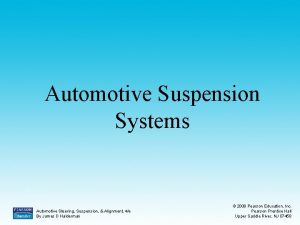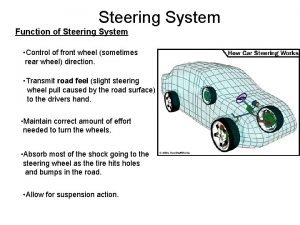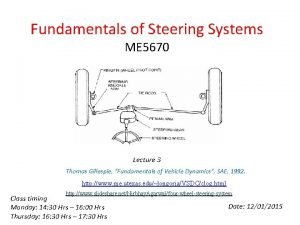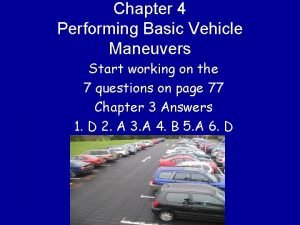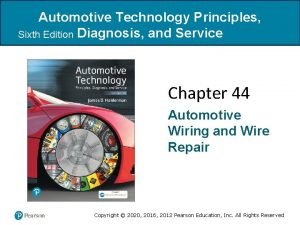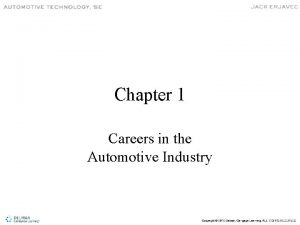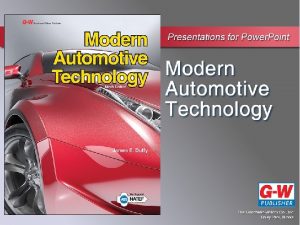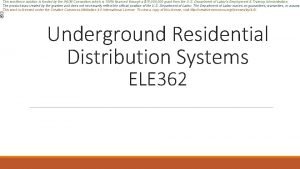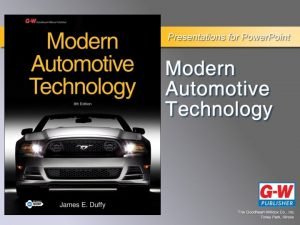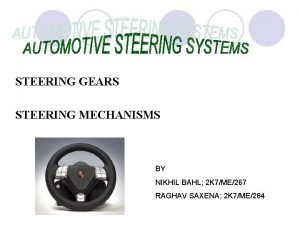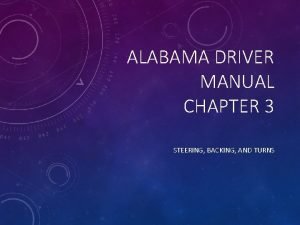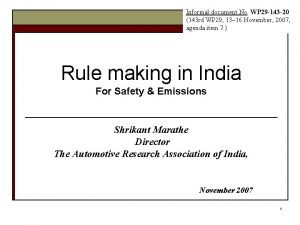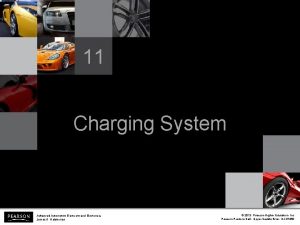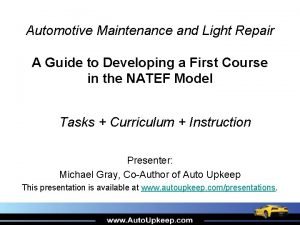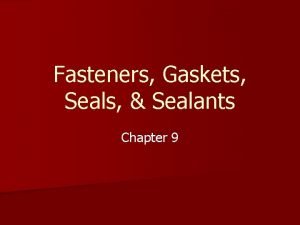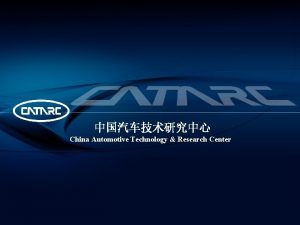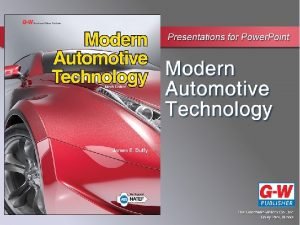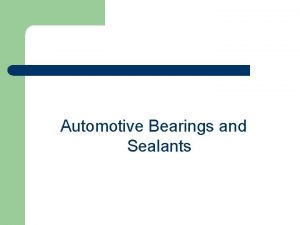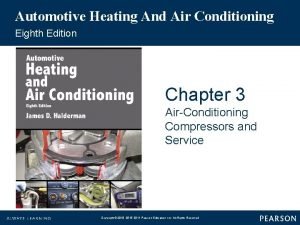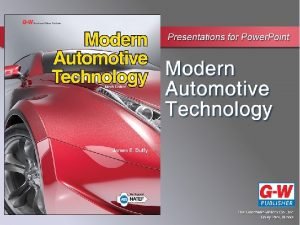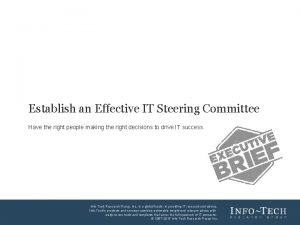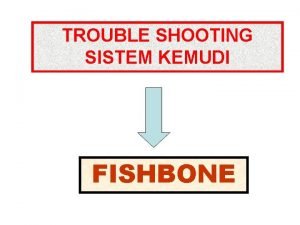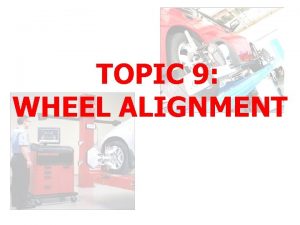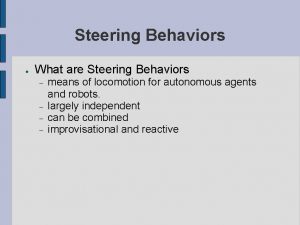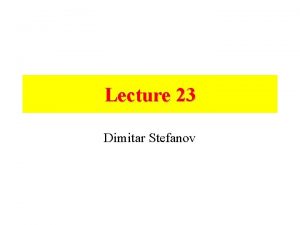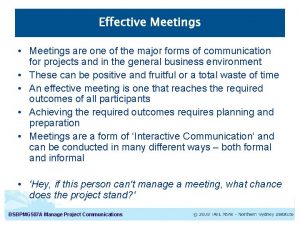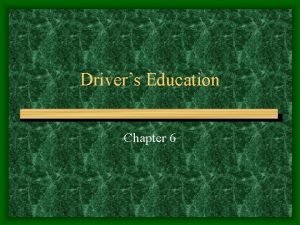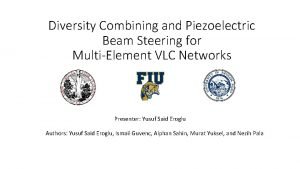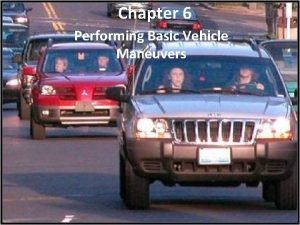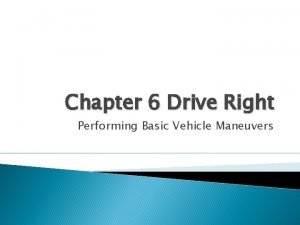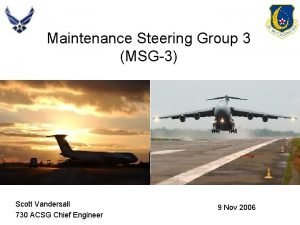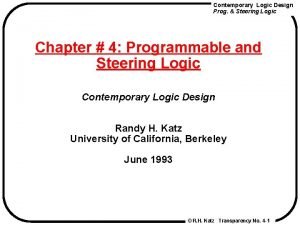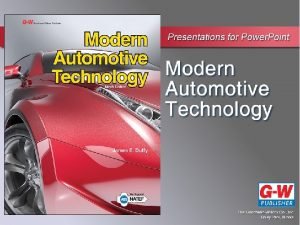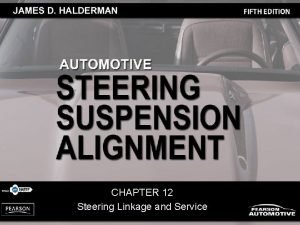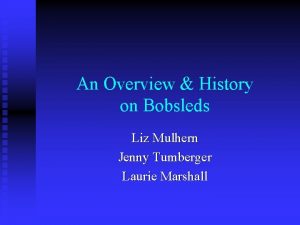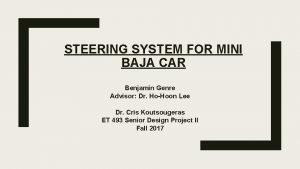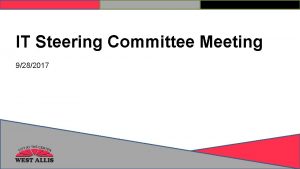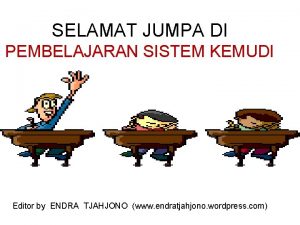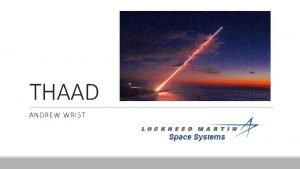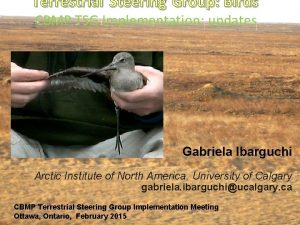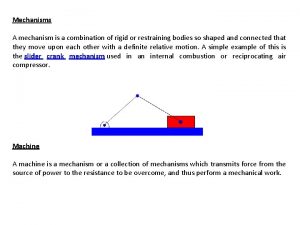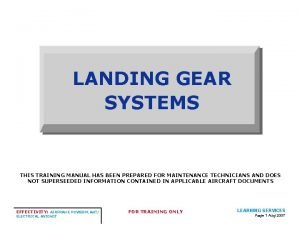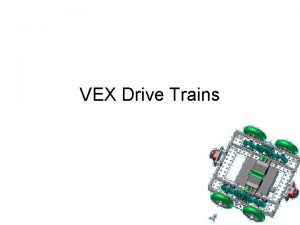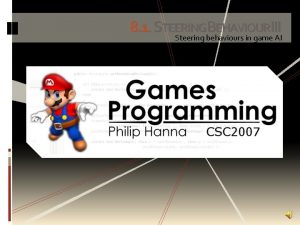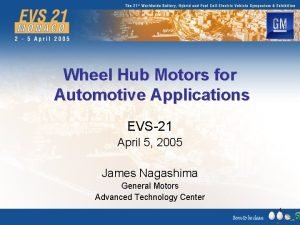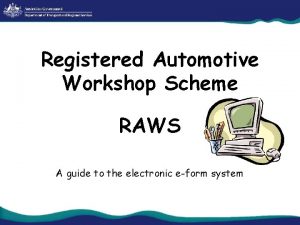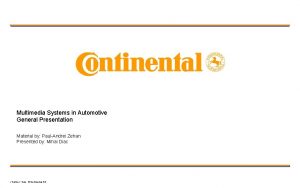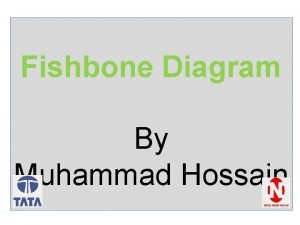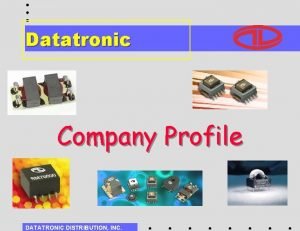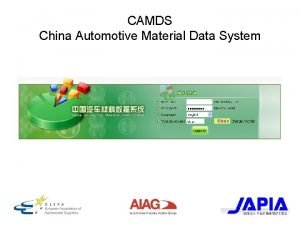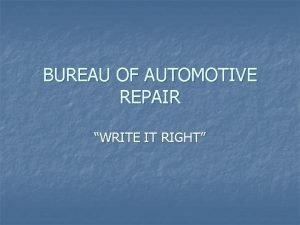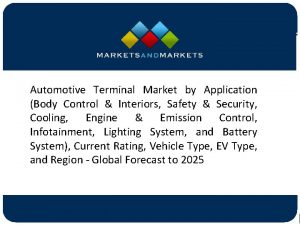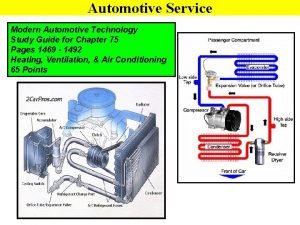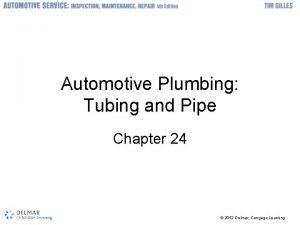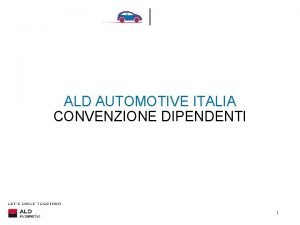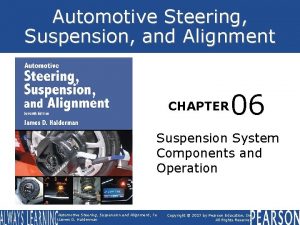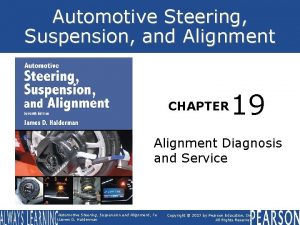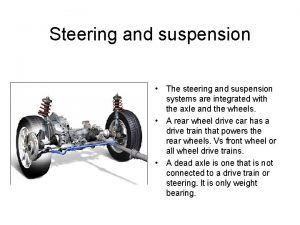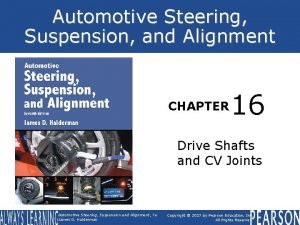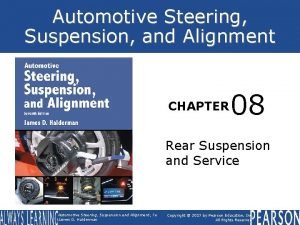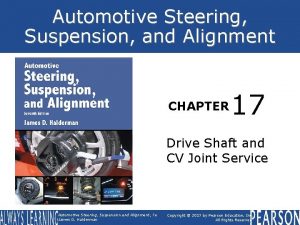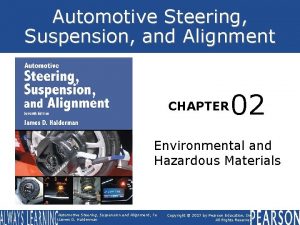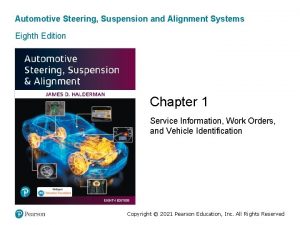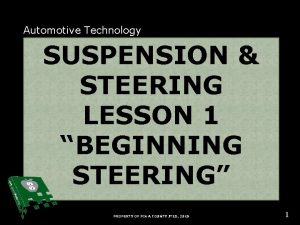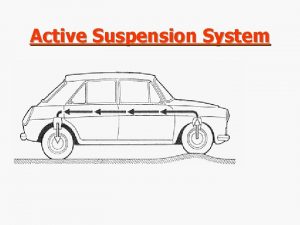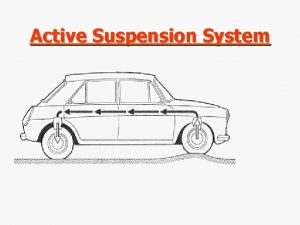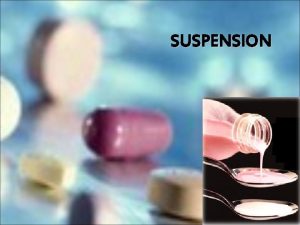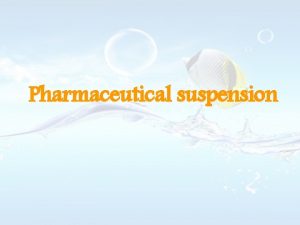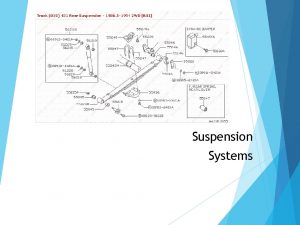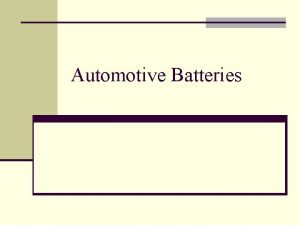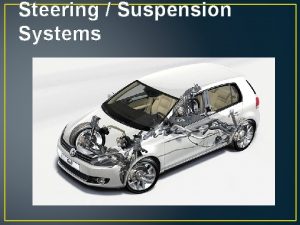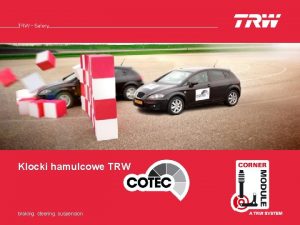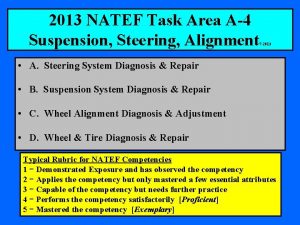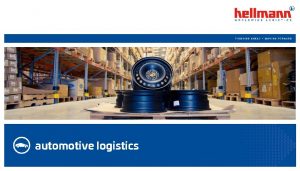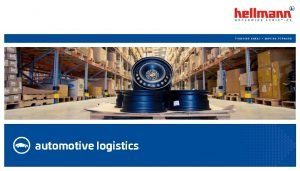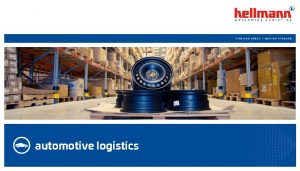Automotive Steering Suspension and Alignment CHAPTER 07 Front












































































- Slides: 76

Automotive Steering, Suspension, and Alignment CHAPTER 07 Front Suspension and Service Automotive Steering, Suspension and Alignment, 7 e James D. Halderman Copyright © 2017 by Pearson Education, Inc. All Rights Reserved

FIGURE 7. 1 Most early vehicles used single straight axles. Automotive Steering, Suspension and Alignment, 7 e James D. Halderman Copyright © 2017 by Pearson Education, Inc. All Rights Reserved

FIGURE 7. 2 Typical kingpin used with a solid axle. Automotive Steering, Suspension and Alignment, 7 e James D. Halderman Copyright © 2017 by Pearson Education, Inc. All Rights Reserved

FIGURE 7. 3 Twin I-beam front suspension. Rubber bushings are used to support the I-beams to the frame and help isolate road noise. Automotive Steering, Suspension and Alignment, 7 e James D. Halderman Copyright © 2017 by Pearson Education, Inc. All Rights Reserved

FIGURE 7. 4 The rubber radius rod bushing absorbs road shocks and helps isolate road noise. Automotive Steering, Suspension and Alignment, 7 e James D. Halderman Copyright © 2017 by Pearson Education, Inc. All Rights Reserved

FIGURE 7. 5 The upper control arm is shorter than the lower control arm on a short/long-arm (SLA) suspension. Automotive Steering, Suspension and Alignment, 7 e James D. Halderman Copyright © 2017 by Pearson Education, Inc. All Rights Reserved

FIGURE 7. 6 A typical SLA-front suspension using coil springs. Automotive Steering, Suspension and Alignment, 7 e James D. Halderman Copyright © 2017 by Pearson Education, Inc. All Rights Reserved

FIGURE 7. 7 An SLA-type suspension with the coil spring placed on top of the upper control arm. Automotive Steering, Suspension and Alignment, 7 e James D. Halderman Copyright © 2017 by Pearson Education, Inc. All Rights Reserved

FIGURE 7. 8 A torsion bar SLA suspension can use either the lower or the upper control arm. Automotive Steering, Suspension and Alignment, 7 e James D. Halderman Copyright © 2017 by Pearson Education, Inc. All Rights Reserved

FIGURE 7. 9 An SLA-type suspension that uses a coil-over-shock assembly. Automotive Steering, Suspension and Alignment, 7 e James D. Halderman Copyright © 2017 by Pearson Education, Inc. All Rights Reserved

FIGURE 7. 10 A typical Mac. Pherson strut showing all of the components of the assembly. A strut includes the shock and the spring in one structural assembly. Automotive Steering, Suspension and Alignment, 7 e James D. Halderman Copyright © 2017 by Pearson Education, Inc. All Rights Reserved

FIGURE 7. 11 The modified strut front suspension is similar to a Mac. Pherson strut suspension except that the coil spring is seated on the lower control arm and is not part of the strut assembly. Automotive Steering, Suspension and Alignment, 7 e James D. Halderman Copyright © 2017 by Pearson Education, Inc. All Rights Reserved

FIGURE 7. 12 The Hi. Per Strut compared to the traditional Mac. Pherson strut. Automotive Steering, Suspension and Alignment, 7 e James D. Halderman Copyright © 2017 by Pearson Education, Inc. All Rights Reserved

FIGURE 7. 13 Multilink front suspension design varies depending on the vehicle manufacturer. Automotive Steering, Suspension and Alignment, 7 e James D. Halderman Copyright © 2017 by Pearson Education, Inc. All Rights Reserved

FIGURE 7. 14 A leaking strut. Either a cartridge insert or the entire strut will require replacement. If a light film of oil is seen, this is to be considered normal. If oil is dripping, then this means that the rod seal has failed. Automotive Steering, Suspension and Alignment, 7 e James D. Halderman Copyright © 2017 by Pearson Education, Inc. All Rights Reserved

FIGURE 7. 15 This front coil spring looks as if it has been heated with a torch in an attempt to lower the ride height of the vehicle. Both front springs will require replacement. Automotive Steering, Suspension and Alignment, 7 e James D. Halderman Copyright © 2017 by Pearson Education, Inc. All Rights Reserved

FIGURE 7. 16 It is easy to see that this worn control arm bushing need to be replaced. The new bushing is shown next to the original. Automotive Steering, Suspension and Alignment, 7 e James D. Halderman Copyright © 2017 by Pearson Education, Inc. All Rights Reserved

FIGURE 7. 17 Grease fitting projecting down from the surrounding area of a ball joint. The ball joint should be replaced when the area around the grease fitting is flush or recessed. Automotive Steering, Suspension and Alignment, 7 e James D. Halderman Copyright © 2017 by Pearson Education, Inc. All Rights Reserved

FIGURE 7. 18 Indicator ball joints should be checked with the weight of the vehicle on the ground. Automotive Steering, Suspension and Alignment, 7 e James D. Halderman Copyright © 2017 by Pearson Education, Inc. All Rights Reserved

FIGURE 7. 19 Typical dial indicator used to measure the suspension component movement. Automotive Steering, Suspension and Alignment, 7 e James D. Halderman Copyright © 2017 by Pearson Education, Inc. All Rights Reserved

FIGURE 7. 20 If the spring is attached to the lower control arm as in this SLA suspension, the jack should be placed under the lower control arm as shown. Automotive Steering, Suspension and Alignment, 7 e James D. Halderman Copyright © 2017 by Pearson Education, Inc. All Rights Reserved

FIGURE 7. 21 The jack should be placed under the lower control arm of this modified Mac. Pherson-type suspension. Automotive Steering, Suspension and Alignment, 7 e James D. Halderman Copyright © 2017 by Pearson Education, Inc. All Rights Reserved

FIGURE 7. 22 If the spring is attached to the upper control arm, the jack should be placed under the frame to check for ball joint wear. Automotive Steering, Suspension and Alignment, 7 e James D. Halderman Copyright © 2017 by Pearson Education, Inc. All Rights Reserved

FIGURE 7. 23 A special tool or a block of wood should be inserted between the frame and the upper control arm before lifting the vehicle off the ground. Automotive Steering, Suspension and Alignment, 7 e James D. Halderman Copyright © 2017 by Pearson Education, Inc. All Rights Reserved

FIGURE 7. 24 The jacking point is under the frame for checking the play of a lower ball joint used with a Mac. Pherson strut. Automotive Steering, Suspension and Alignment, 7 e James D. Halderman Copyright © 2017 by Pearson Education, Inc. All Rights Reserved

FIGURE 7. 25 This worn and rusty ball joint was found by moving the wheel and looking for movement in the joint. Automotive Steering, Suspension and Alignment, 7 e James D. Halderman Copyright © 2017 by Pearson Education, Inc. All Rights Reserved

FIGURE 7. 26 Taper breaker tool being used to separate the upper ball joint from the steering knuckle. This is especially important for vehicles equipped with aluminum alloy control arms. Automotive Steering, Suspension and Alignment, 7 e James D. Halderman Copyright © 2017 by Pearson Education, Inc. All Rights Reserved

FIGURE 7. 27 A pinch bolt attaches the steering knuckle to the ball joint. Remove the pinch bolt by turning the nut, not the bolt. Automotive Steering, Suspension and Alignment, 7 e James D. Halderman Copyright © 2017 by Pearson Education, Inc. All Rights Reserved

FIGURE 7. 28 If the pinch bolt is overtightened, the steering knuckle can be deformed. Automotive Steering, Suspension and Alignment, 7 e James D. Halderman Copyright © 2017 by Pearson Education, Inc. All Rights Reserved

FIGURE 7. 29 By drilling into the rivet, the holding force is released. Automotive Steering, Suspension and Alignment, 7 e James D. Halderman Copyright © 2017 by Pearson Education, Inc. All Rights Reserved

FIGURE 7. 30 The head of the rivet can be removed by using a large-diameter drill bit as shown. Automotive Steering, Suspension and Alignment, 7 e James D. Halderman Copyright © 2017 by Pearson Education, Inc. All Rights Reserved

FIGURE 7. 31 A punch and a hammer being used to remove a rivet after the head has been removed. Automotive Steering, Suspension and Alignment, 7 e James D. Halderman Copyright © 2017 by Pearson Education, Inc. All Rights Reserved

FIGURE 7. 32 Press-in ball joints are best removed using a large C-clamp press, as shown. Automotive Steering, Suspension and Alignment, 7 e James D. Halderman Copyright © 2017 by Pearson Education, Inc. All Rights Reserved

FIGURE 7. 33 Typical kingpin assembly. Automotive Steering, Suspension and Alignment, 7 e James D. Halderman Copyright © 2017 by Pearson Education, Inc. All Rights Reserved

FIGURE 7. 34 Driving a kingpin out with a hammer. Automotive Steering, Suspension and Alignment, 7 e James D. Halderman Copyright © 2017 by Pearson Education, Inc. All Rights Reserved

FIGURE 7. 35 A kingpin being removed showing the worn bushing. Automotive Steering, Suspension and Alignment, 7 e James D. Halderman Copyright © 2017 by Pearson Education, Inc. All Rights Reserved

FIGURE 7. 36 Most shock absorbers used on the front suspension can be removed from underneath the vehicle after removing the attaching bolts or nuts. Automotive Steering, Suspension and Alignment, 7 e James D. Halderman Copyright © 2017 by Pearson Education, Inc. All Rights Reserved

FIGURE 7. 37 Removing the upper strut mounting bolts. Some experts recommend leaving one of the upper strut mount nuts loosely attached to prevent the strut from falling when the lower attaching bolts are removed. Automotive Steering, Suspension and Alignment, 7 e James D. Halderman Copyright © 2017 by Pearson Education, Inc. All Rights Reserved

FIGURE 7. 38 A brake hydraulic hose is often attached to the strut housing. Sometimes all that is required to separate the line from the strut is to remove a spring clip. Automotive Steering, Suspension and Alignment, 7 e James D. Halderman Copyright © 2017 by Pearson Education, Inc. All Rights Reserved

FIGURE 7. 39 Use a strut spring compressor fixture to compress the spring on a Mac. Pherson strut before removing the strut retaining nut. Automotive Steering, Suspension and Alignment, 7 e James D. Halderman Copyright © 2017 by Pearson Education, Inc. All Rights Reserved

FIGURE 7. 40 Removing the strut rod nut. The strut shaft is being helped with one wrench while the nut is being removed with the other wrench. Notice that the spring is compressed before the nut is removed. Automotive Steering, Suspension and Alignment, 7 e James D. Halderman Copyright © 2017 by Pearson Education, Inc. All Rights Reserved

FIGURE 7. 41 Typical Mac. Pherson strut showing the various components. Automotive Steering, Suspension and Alignment, 7 e James D. Halderman Copyright © 2017 by Pearson Education, Inc. All Rights Reserved

FIGURE 7. 42 After installing the replacement strut cartridge, reinstall the spring and upper bearing assembly after compressing the spring. Notice that the strut is being held in a strut spring compressor fixture. Automotive Steering, Suspension and Alignment, 7 e James D. Halderman Copyright © 2017 by Pearson Education, Inc. All Rights Reserved

FIGURE 7. 43 Before final assembly, make sure the marks you made are aligned. Some struts are manufactured with marks to ensure proper reassembly. Automotive Steering, Suspension and Alignment, 7 e James D. Halderman Copyright © 2017 by Pearson Education, Inc. All Rights Reserved

FIGURE 7. 44 The strut on a modified Mac. Pherson strut assembly can be replaced by removing the upper mounting nuts. Automotive Steering, Suspension and Alignment, 7 e James D. Halderman Copyright © 2017 by Pearson Education, Inc. All Rights Reserved

FIGURE 7. 45 Stabilizer bar links should be replaced as a pair. Automotive Steering, Suspension and Alignment, 7 e James D. Halderman Copyright © 2017 by Pearson Education, Inc. All Rights Reserved

FIGURE 7. 46 A strut rod as viewed from the front of the vehicle. Automotive Steering, Suspension and Alignment, 7 e James D. Halderman Copyright © 2017 by Pearson Education, Inc. All Rights Reserved

FIGURE 7. 47 Typical strut rod bushing with rubber on both sides of the frame to help isolate noise, vibration, and harshness from being transferred to the passengers. Automotive Steering, Suspension and Alignment, 7 e James D. Halderman Copyright © 2017 by Pearson Education, Inc. All Rights Reserved

FIGURE 7. 48 Notice that if the front coil springs are sagging, the resulting angle of the lower control arm causes the wheels to move from side to side as the suspension moves up and down. Automotive Steering, Suspension and Alignment, 7 e James D. Halderman Copyright © 2017 by Pearson Education, Inc. All Rights Reserved

FIGURE 7. 49 Spring compressing tool in place to hold the spring as the ball joint is separated. Note that the stabilizer bar links have been removed to allow the lower control arm to move downward enough to remove the coil spring. Automotive Steering, Suspension and Alignment, 7 e James D. Halderman Copyright © 2017 by Pearson Education, Inc. All Rights Reserved

FIGURE 7. 50 The steering knuckle has been disconnected from the lower ball joint. The lower control arm and the coil spring are being held up by a floor jack. Automotive Steering, Suspension and Alignment, 7 e James D. Halderman Copyright © 2017 by Pearson Education, Inc. All Rights Reserved

FIGURE 7. 51 A rubber mallet is being used to support the upper control arm as the lower control is being lowered using a floor jack. Automotive Steering, Suspension and Alignment, 7 e James D. Halderman Copyright © 2017 by Pearson Education, Inc. All Rights Reserved

FIGURE 7. 52 Spring insulators are installed between the spring seat and the coil spring to reduce noise. Automotive Steering, Suspension and Alignment, 7 e James D. Halderman Copyright © 2017 by Pearson Education, Inc. All Rights Reserved

FIGURE 7. 53 The holes in the lower arm are not only used to allow water to drain from the spring seat, but also used as a gauge to show the service technician that the coil spring is correctly seated. Automotive Steering, Suspension and Alignment, 7 e James D. Halderman Copyright © 2017 by Pearson Education, Inc. All Rights Reserved

FIGURE 7. 54 By rotating the adjusting bolt, the vehicle can be raised or lowered. Automotive Steering, Suspension and Alignment, 7 e James D. Halderman Copyright © 2017 by Pearson Education, Inc. All Rights Reserved

FIGURE 7. 55 An adapter and a press or large clamp are used to remove the old bushing from the control arm and to install a new bushing. Automotive Steering, Suspension and Alignment, 7 e James D. Halderman Copyright © 2017 by Pearson Education, Inc. All Rights Reserved

The tools needed to replace a front strut assembly include several sockets and a ball-peen hammer, plus a strut compressor. Automotive Steering, Suspension and Alignment, 7 e James D. Halderman Copyright © 2017 by Pearson Education, Inc. All Rights Reserved

After safely hoisting the vehicle to elbow height and removing the wheel covers, remove the front tire/wheel assembly. Automotive Steering, Suspension and Alignment, 7 e James D. Halderman Copyright © 2017 by Pearson Education, Inc. All Rights Reserved

Remove the two strut retaining nuts. Automotive Steering, Suspension and Alignment, 7 e James D. Halderman Copyright © 2017 by Pearson Education, Inc. All Rights Reserved

Before using a hammer to drive the retaining bolts from the steering knuckle, thread the nut into the bolt backwards to prevent causing damage to the threads. Automotive Steering, Suspension and Alignment, 7 e James D. Halderman Copyright © 2017 by Pearson Education, Inc. All Rights Reserved

Remove the retaining bolts and separate the strut from the steering knuckle. Automotive Steering, Suspension and Alignment, 7 e James D. Halderman Copyright © 2017 by Pearson Education, Inc. All Rights Reserved

Lower the vehicle and remove the upper strut retaining fasteners. Automotive Steering, Suspension and Alignment, 7 e James D. Halderman Copyright © 2017 by Pearson Education, Inc. All Rights Reserved

Hold the strut while removing the last upper retaining nut and then remove the strut assembly. Automotive Steering, Suspension and Alignment, 7 e James D. Halderman Copyright © 2017 by Pearson Education, Inc. All Rights Reserved

After the strut has been removed from the vehicle, install the assembly into a strut compressor. Automotive Steering, Suspension and Alignment, 7 e James D. Halderman Copyright © 2017 by Pearson Education, Inc. All Rights Reserved

Position the jaws of the compressor under the bearing assembly as per the vehicle manufacturer’s instructions. Automotive Steering, Suspension and Alignment, 7 e James D. Halderman Copyright © 2017 by Pearson Education, Inc. All Rights Reserved

Turn the compressor wheel until all tension of the spring has been relieved from the upper bearing assembly. Automotive Steering, Suspension and Alignment, 7 e James D. Halderman Copyright © 2017 by Pearson Education, Inc. All Rights Reserved

Remove the strut retaining nut. Automotive Steering, Suspension and Alignment, 7 e James D. Halderman Copyright © 2017 by Pearson Education, Inc. All Rights Reserved

Remove the strut assembly. Automotive Steering, Suspension and Alignment, 7 e James D. Halderman Copyright © 2017 by Pearson Education, Inc. All Rights Reserved

Before installing the replacement strut, check the upper bearing by exerting a downward force on the bearing while rotating and check for roughness. Replace if necessary. Automotive Steering, Suspension and Alignment, 7 e James D. Halderman Copyright © 2017 by Pearson Education, Inc. All Rights Reserved

Install the strut from underneath the spring compressor fixture. Automotive Steering, Suspension and Alignment, 7 e James D. Halderman Copyright © 2017 by Pearson Education, Inc. All Rights Reserved

Install the strut retaining nut. Most vehicle manufacturers specify that the strut retaining nut be replaced and the old one discarded. Automotive Steering, Suspension and Alignment, 7 e James D. Halderman Copyright © 2017 by Pearson Education, Inc. All Rights Reserved

Before loosening the tension, check that the coil spring is correctly located at both the top and the bottom, then release the tension on the spring. Automotive Steering, Suspension and Alignment, 7 e James D. Halderman Copyright © 2017 by Pearson Education, Inc. All Rights Reserved

Remove the strut assembly from the compressor and back of the vehicle and install the upper fasteners. Do not torque to specifications until the lower fasteners have been installed. Automotive Steering, Suspension and Alignment, 7 e James D. Halderman Copyright © 2017 by Pearson Education, Inc. All Rights Reserved

Attach the lower strut to the steering knuckle using the original hardened bolts and nuts. Automotive Steering, Suspension and Alignment, 7 e James D. Halderman Copyright © 2017 by Pearson Education, Inc. All Rights Reserved

Using a torque wrench, torque all fasteners to factory specifications. Automotive Steering, Suspension and Alignment, 7 e James D. Halderman Copyright © 2017 by Pearson Education, Inc. All Rights Reserved

Install the tire/wheel assembly, lower the vehicle, and torque the lug nuts to factory specifications. Align the vehicle before returning it to the customer. Automotive Steering, Suspension and Alignment, 7 e James D. Halderman Copyright © 2017 by Pearson Education, Inc. All Rights Reserved
 Halderman
Halderman Functions of steering
Functions of steering Ackerman steering mechanism
Ackerman steering mechanism Local and global alignment
Local and global alignment Global vs local alignment
Global vs local alignment Pam1250
Pam1250 Sequence alignment
Sequence alignment Jonathan pevsner
Jonathan pevsner Movement in axial suspension
Movement in axial suspension Chapter 4 performing basic maneuvers answer key
Chapter 4 performing basic maneuvers answer key Chapter 44 automotive wiring and wire repair
Chapter 44 automotive wiring and wire repair Chapter 2 automotive careers and ase certification
Chapter 2 automotive careers and ase certification Picture of warm front
Picture of warm front Emission control system components
Emission control system components Dead front vs live front transformer
Dead front vs live front transformer Front
Front Chapter 76 suspension system diagnosis and repair answers
Chapter 76 suspension system diagnosis and repair answers Cam and peg steering gear
Cam and peg steering gear What is push pull feed steering
What is push pull feed steering Module 3 topic 4 basic maneuvering steering and braking
Module 3 topic 4 basic maneuvering steering and braking Automotive regulations and standards
Automotive regulations and standards Automotive technology sixth edition
Automotive technology sixth edition Advanced automotive electric
Advanced automotive electric Automotive maintenance and light repair answer key
Automotive maintenance and light repair answer key Fasteners gaskets seals and sealants
Fasteners gaskets seals and sealants China automotive technology and research center
China automotive technology and research center Chapter 8 fasteners gaskets seals and sealants
Chapter 8 fasteners gaskets seals and sealants Automotive bearings and seals
Automotive bearings and seals Automotive heating and air conditioning 8th edition
Automotive heating and air conditioning 8th edition What fastens the rear of a leaf spring to the car frame
What fastens the rear of a leaf spring to the car frame Primary objective of it steering committee
Primary objective of it steering committee Backlash steering dapat dipengaruhi oleh… *
Backlash steering dapat dipengaruhi oleh… * Steering axis
Steering axis Craig reynolds steering behaviors
Craig reynolds steering behaviors Steering angle formula
Steering angle formula Implement steering
Implement steering Steering committee meeting agenda sample
Steering committee meeting agenda sample How do you steer straight forward select all that apply
How do you steer straight forward select all that apply Beam steering
Beam steering A turnabout is a maneuver for *
A turnabout is a maneuver for * Steering straight backward
Steering straight backward Steering control in strategic management
Steering control in strategic management Budget steering committee
Budget steering committee Maintenance steering group 3
Maintenance steering group 3 Steering logic
Steering logic Steering axis inclination
Steering axis inclination Haltenberger steering system
Haltenberger steering system Bobsled steering system
Bobsled steering system Sae baja rack and pinon
Sae baja rack and pinon It steering committee agenda
It steering committee agenda Komponen steering linkage
Komponen steering linkage Guiding principles of ncf 2005
Guiding principles of ncf 2005 Webomr
Webomr Auto steering system
Auto steering system Thermally initiated venting system
Thermally initiated venting system Steering in birds
Steering in birds Correct steering equation
Correct steering equation Landing
Landing Vex mecanum wheels
Vex mecanum wheels It steering committee
It steering committee Steering behaviours
Steering behaviours Wheel hub motors for automotive applications
Wheel hub motors for automotive applications Dristas utm
Dristas utm Sap hana for automotive
Sap hana for automotive Raws workshop
Raws workshop True automotive
True automotive V cycle automotive
V cycle automotive Automotive aftermarket solutions
Automotive aftermarket solutions Low customer satisfaction cause and effect diagram
Low customer satisfaction cause and effect diagram Datatronic automotive
Datatronic automotive Camds imds
Camds imds Write it right bureau of automotive repair
Write it right bureau of automotive repair Automotive terminal market
Automotive terminal market Modern automotive technology answer key
Modern automotive technology answer key Automotive plumbing
Automotive plumbing Michael schaffert
Michael schaffert Ald automotive permuta
Ald automotive permuta
